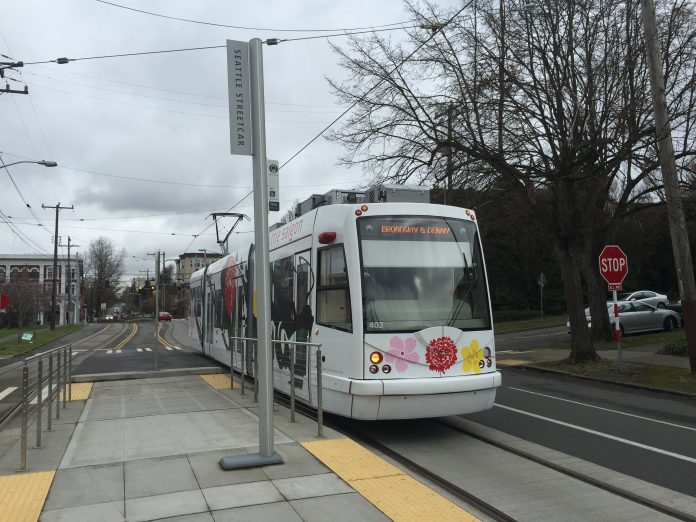A spate of new transit spot improvements in Seattle are in the works for this year, which should go a long way to improving the performance of dozens of transit lines. Spot improvements are headed to Ballard, Belltown, Denny Triangle, and Pioneer Square to Capitol Hill.
First Hill Streetcar Corridor Improvements

To improve speed and reliability on the First Hill Streetcar corridor, SDOT plans to use a variety of techniques to aid the streetcar line. Many of these transit improvements will also aid routes like Route 9 and 60:
- On the Broadway stretch from Pine Street to Marion Street, SDOT will deploy transit signal priority, provide new south business access and transit (BAT) lane, convert the center turn pocket to a general travel lane, and aid right-turning cars during afternoon peak hours by restricting pedestrian crossings.
- On the Yesler Way stretch between Boren Avenue and 14th Ave E, SDOT will restrict left turns during afternoon peak hours, retime signals at the 12th Avenue intersection, add transit signal priority, and improve stop signage.
- On the S Jackson St stretch between Occidental Ave S and 14th Ave E, SDOT will remove some on-street parking (six to seven stalls) near the Little Saigon stop, deploy transit signal priority, and adjust eastbound and westbound signals to help the streetcars.
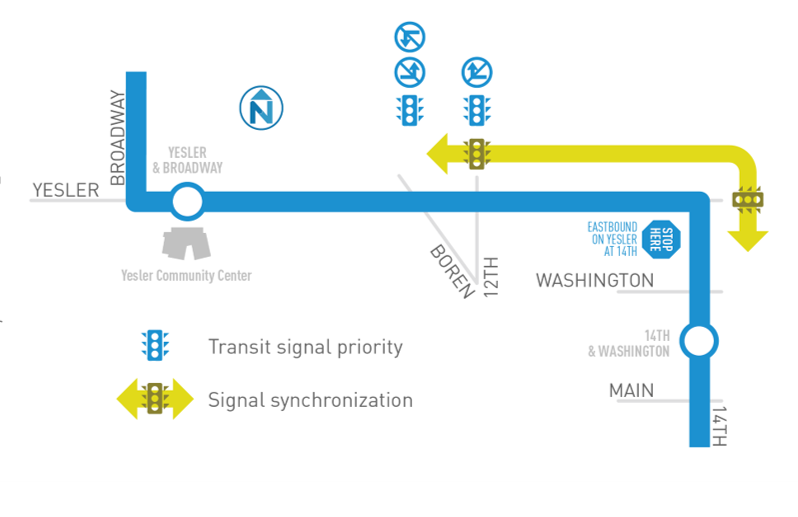
Unfortunately, the First Hill Streetcar line has been temporarily suspended due to an mechanical issue discovered last week. The line was abruptly shut down on Wednesday when one trainset stalled at Broadway and Yesler Way. SDOT says that service will resume shortly, but hasn’t given a precise date. The stalled trainset is one of seven trainsets built by Czech-based manufacturer Inekon Trams, and six of them were put into full passenger service last year on the First Hill Streetcar line. According to technicians, none of the other trainsets appear to have similar issues, but tests will be carried out before they’re put back in to passenger service.
Blanchard Bus Lanes
On an average weekday, some 22,000 bus passengers and 200 buses traverse Blanchard Street, which can mean severe delays during peak hours. SDOT plans to change that in the coming weeks. A total of three-and-a-half blocks between Eighth Avenue and Third Avenue will get the bus-only lane treatment, which should help speed up and improve reliability on the RapidRide C and Route 40 bus lines. Blanchard, a one-way street, sends vehicles in the northeast-bound direction with buses headed toward Westlake Avenue. The bus-only lane will be in effect on weekdays only during peak hours, 6am to 9am and 3pm to 7pm, and should shave off about an average of four minutes in travel time for bus riders (assuming motorists obey the peak hour prohibition).
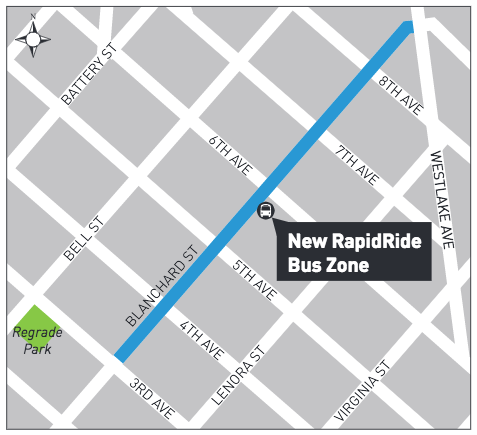
The blocks between Eighth Avenue and Westlake Avenue will be on hold for now so that SDOT can work out signal details for the Westlake Avenue intersection. A future RapidRide stop is also a possibility for a future transit project. That stop would likely be located just west of Sixth Avenue.
Dongho Chang, the City’s Chief Transportation Engineer, recently gave a preview of the Blanchard Street improvements where SDOT is already putting test paint on the ground.
Layout for new bus only lane on Blanchard. pic.twitter.com/6fIReGv9d0
— Dongho Chang (@dongho_chang) February 26, 2017
Construction on the project should wrap up this spring. Blanchard is a very common bike route, with the possibility of protected bike lanes coming in future years. Amazon constructed one block of a one-way protected bike lane in front of its new building between Seveny and Eighth Avenues, but many frequent cyclists have noted that it’s on the wrong side of the street to be of use to most riders: SDOT has confirmed it is looking into the best way to expand cycling facilities on Blanchard. In the meantime, bicyclists are left to use the bus-only lane, separated to some degree from general traffic.
Olive Way Bus Lanes
Like Blanchard Street, buses suffer on Olive Way in Downtown Seattle, particularly express buses in the stretch between Fourth Avenue and Minor Avenue. SDOT is planning to help partially alleviate the pain by adding a queue jump for buses at the Boren Avenue intersection and creating a bus-only lane between Terry Avenue and Minor Avenue–a two-block stretch. The bus-only lane will be added by converting a short-lived westbound right-turn-only lane–a feature of the street that only exists on the Terry-Minor stretch. The effect of this change will be a fully one-way street street between Fourth Avenue and Melrose Avenue.
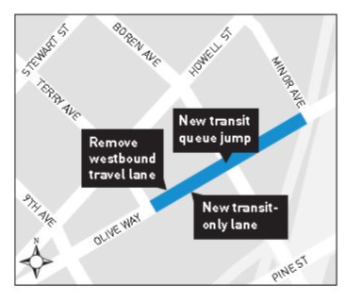
Though a modest improvement, it could prove highly useful since that portion of Olive Way is often plagued by traffic queuing onto I-5, leaving buses out to dry in stop-and-go traffic. The improvements will mainly benefit outbound transit riders from Downtown, but it could have reverberating effects on the overall reliability of the express routes that use the corridor as a means to enter I-5 northbound.
SDOT plans to bring the changes to Olive Way in full this spring.
@seattledot appears set to extend bus lane on Olive Way and reverse WB lane between Minor and Boren. Can you shed any light @dongho_chang? pic.twitter.com/NZ1MGVCGZE
— Northwest Urbanist (@NWUrbanist) March 2, 2017
Spring Street Bus Lane
2017 will also finally see the implementation of a bus-only lane on Spring Street, helping the Route 2 through an infamously gridlocked stretch of Downtown traffic. We wrote about this project back in 2015, but it’s finally getting put in this year. This change will essentially be the first transit improvement put in place for the Madison BRT line (RapidRide G) but which will provide immediate benefits on one of Downtown’s most frequently used trolley routes. The bus lane will run from Third Avenue to Sixth Avenue, with a queue jump at Sixth Avenue allowing buses to get a head start on traffic trying to enter I-5 there.
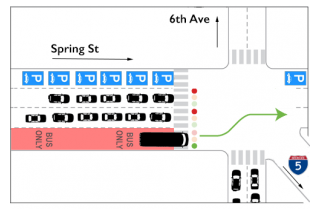
Ballard Transit and Greenway Improvement
Separately, SDOT is planning to improve a five-block stretch of 15th Ave NW in Ballard for buses and pedestrians. Between NW Market St and NW 50th St, the roadway on 15th Ave NW is five to six travel lanes wide plus a precarious turn pocket median. This roadway carries some 50,000 vehicles daily and regularly experiences some of the worst congestion in Seattle. Much of the congestion can be attributed to the fact that the Ballard Bridge crossing over Salmon Bay is one of the few connections between north and central Seattle. During peak hours the stoplight at NW Market St can lead to big backups, but the same is true at times when the Ballard Bridge is raised for boats.
15th Ave NW is a primary bus corridor with frequent bus service by the RapidRide D line and weekday peak-hour express 15X. SDOT plans to help alleviate some of the congestion that bus riders can experience by adding a BAT lane in the northbound direction. Motorists can still directly access businesses on the east side of the street, but transit will otherwise have priority allowing buses to jump ahead of traffic to NW Market St.
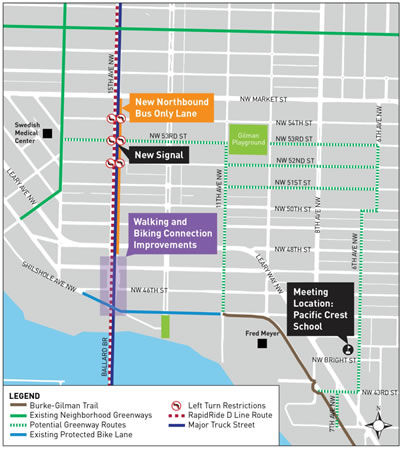
That project will also involve other changes to the roadway to address congestion and pedestrian mobility. SDOT will add a new median barrier between NW 52nd St and NW 54th St, which should eliminate some east-west vehicular traffic. At peak times, the turn pocket that the median barrier is replacing all but impossible to cross. But the new median barrier will prohibit left turns at all times, forcing some motorists to slightly modify their trips. The benefits of this, however, are safety and added mobility for pedestrians. That’s because the median barrier will eliminate potential collisions and provide a new means for pedestrians to cross the street.
According to SDOT’s analysis, the existing turn pocket isn’t designed for the types of volumes and number of lanes on the roadway, which could be contributing to higher collision rates.

The median barrier will also come with a pedestrian activated signal on NW 53rd St. This will allow pedestrians to call for yield lights to stop approaching vehicles and pass across the roadway. In the middle of the street, the median will be designed to accommodate a pedestrian refuge island, giving pedestrians an added measure of safety crossing the street. With the crossing planned for NW 53rd St, the new pedestrian facility should help add to the Ballard Greenway network and improve overall pedestrian connectivity across 15th Ave NW.

The final road design should look something similar to the cross-section below. At least one lane in each direction will be wide enough for freight and buses to use while the general travel lane will still be generous in width.

Construction of the project should begin toward the end of this year.
Stephen is a professional urban planner in Puget Sound with a passion for sustainable, livable, and diverse cities. He is especially interested in how policies, regulations, and programs can promote positive outcomes for communities. With stints in great cities like Bellingham and Cork, Stephen currently lives in Seattle. He primarily covers land use and transportation issues and has been with The Urbanist since 2014.


